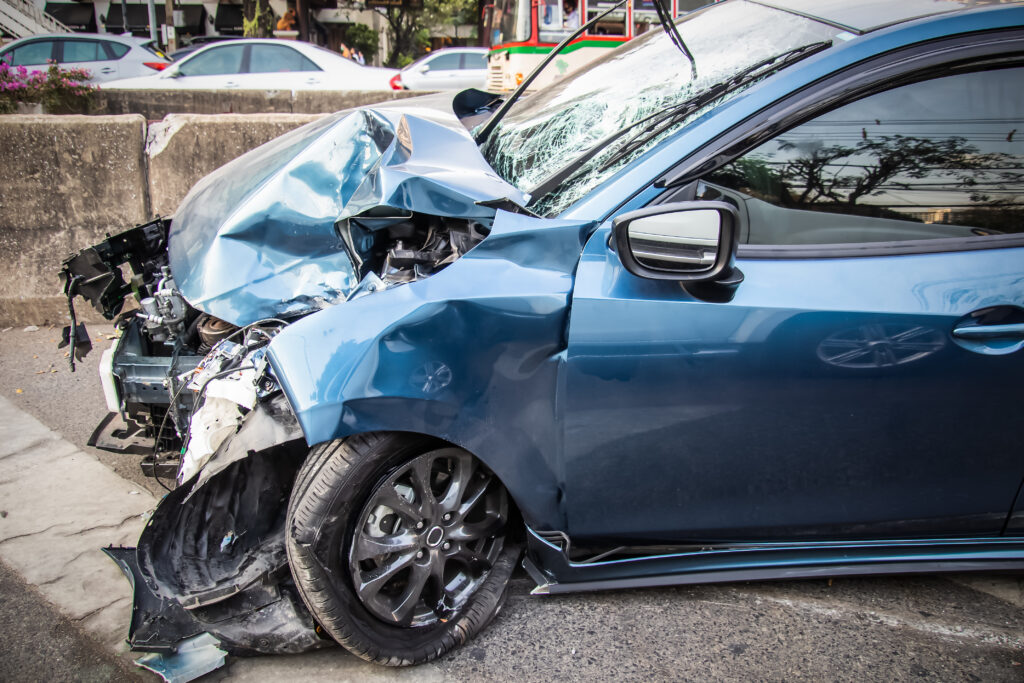Car accidents resulting from others’ negligence can bring about debilitating injuries and high medical costs. Following a car crash, you should anticipate ongoing medical treatment, dealings with insurance company representatives, and, in some cases, litigation. These processes can be extremely difficult to navigate on your own. Therefore, it’s essential that you have a skilled car accident attorney in Chula Vista representing you throughout your case.
A knowledgeable car accident lawyer can handle the legal components of your case while you concentrate on completing your medical treatment. Once your medical treatment is complete, your lawyer can file a claim on your behalf, negotiate with insurance company adjusters, or take your case to court, depending on the circumstances.
Schedule A Free Case Evaluation Today!
How do Negligent Drivers Most Frequently Cause Car Accidents?
Negligent drivers contribute significantly to car accidents through various types of car collisions, each with distinct causes and consequences.
- One common type of collision that results from negligent drivers is the rear-end accident. This type of accident occurs when a driver fails to maintain a safe distance from the vehicle in front, often due to distractions such as texting, adjusting the radio, or even drowsiness. Rear-end collisions can result in whiplash injuries for the occupants of the vehicle that was struck, as well as damage to both vehicles involved.

- Another type is the intersection collision, where drivers fail to yield the right-of-way or run red lights. This negligence can lead to broadside (or T-bone) collisions, where the front of one vehicle strikes the side of another. Such accidents are particularly dangerous because the side of a car offers less protection compared to the front or rear.
- Negligent lane changing is also a significant cause of accidents. Drivers who fail to signal or check blind spots before changing lanes can collide with other vehicles, causing sideswipes or even forcing cars off the road. These accidents are often avoidable with proper signaling and awareness of surroundings.
- Distracted driving, increasingly common with the use of smartphones, is another major contributor to accidents. Texting, talking on the phone, or even eating while driving diverts attention from the road, increasing the likelihood of collisions. Even a moment’s distraction can lead to devastating consequences.
- Speeding, though a clear violation of traffic laws, remains a frequent cause of accidents. Excessive speed reduces a driver’s ability to react to unexpected situations and increases the severity of collisions. Combined with other forms of negligence, speeding can amplify the likelihood of accidents and their potential for causing serious injury or death.
- Impaired driving, whether due to alcohol, drugs, or fatigue, also significantly increases accident risks. Impaired drivers have slower reaction times, impaired judgment, and reduced coordination, making them more likely to cause accidents through reckless maneuvers or failure to respond to changing traffic conditions.
- Finally, weather and road conditions exacerbate these risks when drivers fail to adjust their driving behavior accordingly. Negligent drivers may not reduce speed or increase following distances in rain, snow, or fog, contributing to weather-related accidents.
If you suffered injuries in a negligence-related car crash, a skilled car accident attorney can investigate your circumstances to determine how the accident occurred and who was at fault. Your lawyer can then file a claim with the at-fault party’s insurance company and begin negotiating for the compensation you deserve.
What Typically Happens in the Aftermath of a Car Crash?
In the immediate aftermath of a car crash, there are several important steps and considerations that typically unfold for those involved:
- Reporting to Insurance Companies – Shortly after the accident, individuals involved will need to report the incident to their respective insurance companies. This involves providing details such as the time, location, and circumstances of the accident. Insurance companies will begin their own investigations into the incident and may request additional information or documentation.
- Seeking Follow-up Medical Care – While initial treatment may have been received at the scene or in the emergency room, follow-up medical care is often necessary. This can include visits to primary care physicians, specialists such as orthopedists or neurologists, physical therapists, or chiropractors. Continuing medical treatment helps monitor recovery progress and addresses any ongoing issues resulting from the car accident.

- Documenting and Tracking Medical Expenses – Throughout the recovery process, individuals should keep careful records of all medical expenses incurred due to the accident. This includes bills from hospitals, doctors, pharmacies, rehabilitation centers, and any other healthcare providers. These records are essential for accurately assessing and claiming medical expenses as part of a potential legal claim or insurance settlement.
- Repairing or Replacing Damaged Vehicles – If vehicles involved in the accident were damaged, owners will need to arrange for repairs or, in severe cases, replacements. This process involves obtaining repair estimates, coordinating with insurance adjusters, and selecting repair shops. Insurance coverage and deductibles are factors that affect how repairs or replacements are handled.
- Dealing with Emotional and Psychological Effects – Car accidents can have lasting emotional and psychological effects on the individuals involved. It’s common for accident victims to experience anxiety, depression, insomnia, or post-traumatic stress disorder (PTSD) following a traumatic event. Seeking support from mental health professionals, counselors, or support groups can be beneficial in managing these emotional challenges.
- Legal Considerations and Consultations – In the aftermath of a car crash, experienced personal injury attorneys can provide guidance on filing insurance claims, negotiating settlements, or pursuing legal action through the state court system. Once a lawyer files an insurance claim on your behalf, they can negotiate that claim with the adjuster. However, if the insurance company disputes fault for the accident or refuses to offer you fair compensation, your lawyer can pursue litigation in the court system and, if necessary, resolve your case at a jury trial or alternative dispute resolution (ADR) proceeding.
- Litigation Proceedings – If litigation becomes necessary in your case, your car accident attorney can handle every step of the process for you and represent you during all proceedings. Litigation involves filing a legal complaint in the court system, taking part in discovery, continuing settlement negotiations, and, if necessary, resolving the case at a trial or ADR proceeding.
Navigating the aftermath of a car crash involves managing medical care, insurance claims, vehicle repairs, and emotional well-being. Seeking timely and appropriate assistance from medical professionals and experienced legal counsel can help injured individuals effectively address the challenges and recover from the effects of their recent car crashes.
What Do You Need to Prove in a Car Accident Case?
As the victim in a car accident case, several legal elements must typically be proven to establish liability and seek compensation for injuries and damages:
- Duty of Care – The first element involves showing that the defendant (the person you’re suing) owed you a duty of care. In car accident cases, this duty is generally established by demonstrating that all drivers have a legal obligation to drive safely and obey all traffic laws.
- Breach of Duty – Next, you must prove that the defendant breached their duty of care. This means showing that the defendant failed to act with the level of care that a reasonably prudent person would have exercised under similar circumstances. Examples may include speeding, running a red light, or driving while distracted.
- Causation – You need to establish a causal connection between the defendant’s breach of duty and the accident that caused your injuries or damages. This requires demonstrating that the defendant’s actions (or inactions) directly led to the accident and your resulting injuries.
- Damages – Finally, you must prove that you suffered actual damages as a direct and proximate result of the accident. Damages can include medical expenses, property damage, lost income, pain and suffering, and other related costs. Evidence such as medical bills, repair estimates, and testimony from medical experts or witnesses may be used to substantiate your claim for damages.
To successfully navigate a car accident case, it’s essential to gather and present evidence that supports each of these legal elements. This often involves collecting police reports, witness statements, medical records, and documentation of financial losses. Additionally, consulting with an experienced car accident attorney can be crucial in building a strong case and advocating for your rights throughout the legal process.
A knowledgeable car accident lawyer can gather the evidence necessary to satisfy the legal burden of proof in your case. By proving these legal elements, you can strengthen your position in seeking compensation for the full extent of your losses and injuries.
What are the Most Common Car Accident Injuries?
Car accidents can result in a variety of injuries for both drivers and passengers, ranging from minor to severe:
- Among the most common injuries is whiplash, which occurs when the neck is forcefully jerked back and forth upon impact. Whiplash can lead to neck pain, stiffness, headaches, and, in some cases, long-term discomfort.
- Head injuries are also prevalent, especially when the victim’s head strikes the steering wheel, dashboard, or windows upon impact. Concussions, skull fractures, and traumatic brain injuries (TBIs) can result, varying in severity from mild to life-threatening. Symptoms may include dizziness, confusion, nausea, and, in severe cases, cognitive impairments.
- Chest injuries are also common due to the impact of the seatbelt or steering wheel during a collision. Rib fractures, internal bleeding, and organ damage can occur, particularly if the victim’s chest experiences blunt trauma. Seatbelt syndrome, which causes bruising and internal injuries where the seatbelt restrains the body, is also a frequent occurrence.
- Extremity injuries, such as fractures, sprains, and strains, are typical in car accidents. These injuries often result from the force exerted on the limbs upon impact or from being crushed. Ankles, knees, and wrists are particularly vulnerable due to their exposure and lack of protection.
- Back injuries, including spinal cord injuries (SCI) and herniated discs, can occur when the spine is jolted or twisted during a crash. These injuries may lead to chronic pain, limited mobility, and, in severe cases, paralysis.
- Psychological injuries, such as post-traumatic stress disorder (PTSD), anxiety, and depression, can also affect car accident survivors. Emotional distress may result from the trauma of the accident itself, witnessing injuries or fatalities, or from the long-term effects of physical injuries on daily life.
Recoverable Damages in Car Accident Cases
Determining the value of a car accident case involves assessing various factors to arrive at a fair compensation amount for the victim. Several key elements contribute to this evaluation:
- Extent of Damages – The first step is to quantify the damages that the victim suffered. This includes medical expenses, such as hospital bills, surgeries, medications, rehabilitation, and ongoing treatment costs. The severity of injuries and their effect on the victim’s future health are also considered.
- Lost Income – Compensation may cover lost income if the victim was unable to work due to the injuries they sustained in the accident. Future earning capacity may also be evaluated if the injuries result in a long-term or permanent disability that affects the victim’s ability to work.

- Property Damage – Costs associated with repairing or replacing damaged vehicles and other property are included in the assessment. This typically involves obtaining repair estimates or documentation of the fair market value of the vehicle if it was totaled.
- Pain and Suffering – Non-economic damages, such as physical pain, emotional distress, and loss of enjoyment of life, are also factored into the case valuation. Assigning a monetary value to pain and suffering often involves subjective assessment based on the severity and duration of the victim’s injuries.
- Punitive Damages – In cases involving particularly reckless or egregious behavior by the at-fault party, punitive damages may be awarded. These are intended to punish the defendant and deter similar conduct in the future rather than compensate the victim for specific losses.
If you suffered injuries in a car crash, a knowledgeable car accident attorney in your jurisdiction can estimate the likely settlement or verdict value of your case and aggressively negotiate with insurance company representatives on your behalf. If the insurance company adjuster refuses to increase their offer, then your lawyer may threaten them with litigation in the state court system.
Speak with an Experienced Car Accident Lawyer About Your Legal Matter Today
If you sustained injuries in a recent car crash, a knowledgeable lawyer can handle every step of the process for you. Your Chula Vista personal injury attorney can help you understand what to expect, explain your legal options in clear terms, answer your questions, and work to maximize the total compensation award you receive.

